
How to write your CV education section + examples
Your education section of your CV is crucial part of the document.
But it can be tough to know to write, where to put it, and what you should include.
This guide will show you exactly how to write an impressive education section for your own CV, whether you are a school leaver, experienced professional, or anything in between.
Where to put your education on your CV?
Where you position your education section on your CV will largely depend on your level of experience and how long ago you left full-time education.
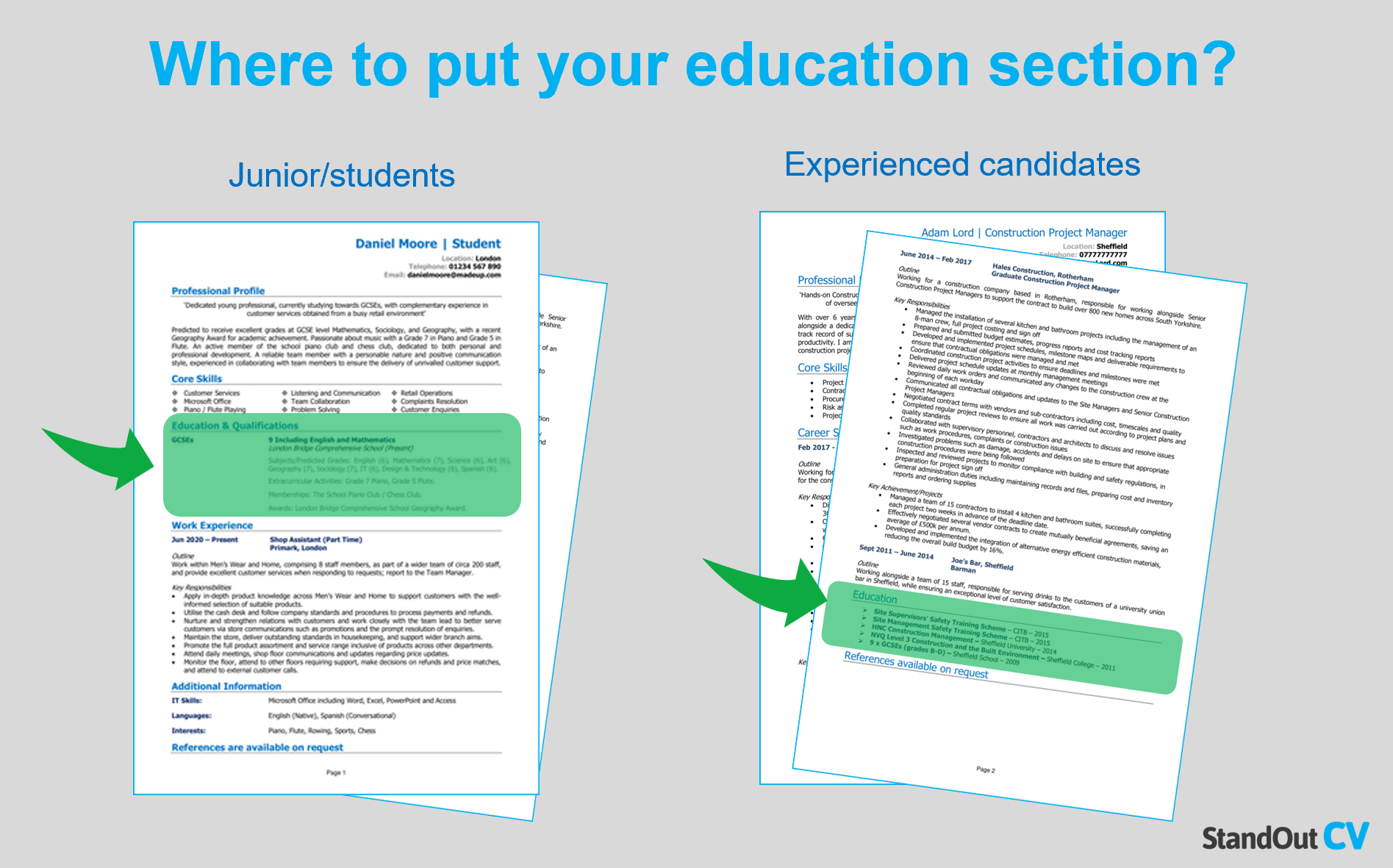
- Little/no experience – If you’re just leaving education and therefore don’t have a lot of experience behind you, place your education section nearer the top of your CV, under your personal profile . Be sure to go into plenty of detail because, at this point in your career, your academic record will receive more attention, and employers will need lots of info to be persuaded to hire you.
- Experienced candidate – If you’re a more experienced candidate who has gained skills and knowledge through past positions, your employment history takes precedence. In this case, your education section should go under your employment section because employers are likely to be more interested in your real-world experience – although they will still value your education.
CV templates
What to include in your education section?
This section should outline your formal education, qualifications and certificates in reverse chronological order. Here’s an overview of what this might include:
- Degree – As a university graduate, you need to include your degree , and if you’ve got post-graduate qualifications, your most recent degree must come first. To do this, include the name of the university, the title of your degree, the dates you studied there and the grade you received. You might also wish to include details of any relevant modules you studied
- A-levels – If you took A-levels at college, you probably completed three to four subjects. Be sure to include the name of your college, the dates you studied there and the subjects you completed.
- Vocational qualifications – School or college aren’t the end of the road for your education but if you chose not to study a degree, you may have obtained other vocational qualifications. If so, you need to include these too. Follow the same formatting rules by including the name of the institution, the qualification and the date you achieved it
- GCSEs – Listing your GCSEs can be trickier as there are often more of these. So if you have lots of GCSEs, include your school name, the years you were there and then abbreviate your list of subjects. For example, ‘10 GCSEs including maths and English’
- Mandatory certificates – There might be mandatory training you need to undertake to get a job, for example, health and safety certificates. In this case, you should include these in your education section, listing the level of certification, name of the course and date you received it. You might also wish to include the name of the accrediting body if they are well-known in the industry.
Education section examples
Now you have a better understanding of what could be included in your education section, let’s take a closer look at how these should be written with some examples.
School leaver
As a school leaver hoping to land a job, it’s likely that your GCSEs are going to be your highest level of qualification.
When adding these to your CV, you should include the full name of your school and the dates you attended. Underneath this, you can begin to outline your GCSEs.
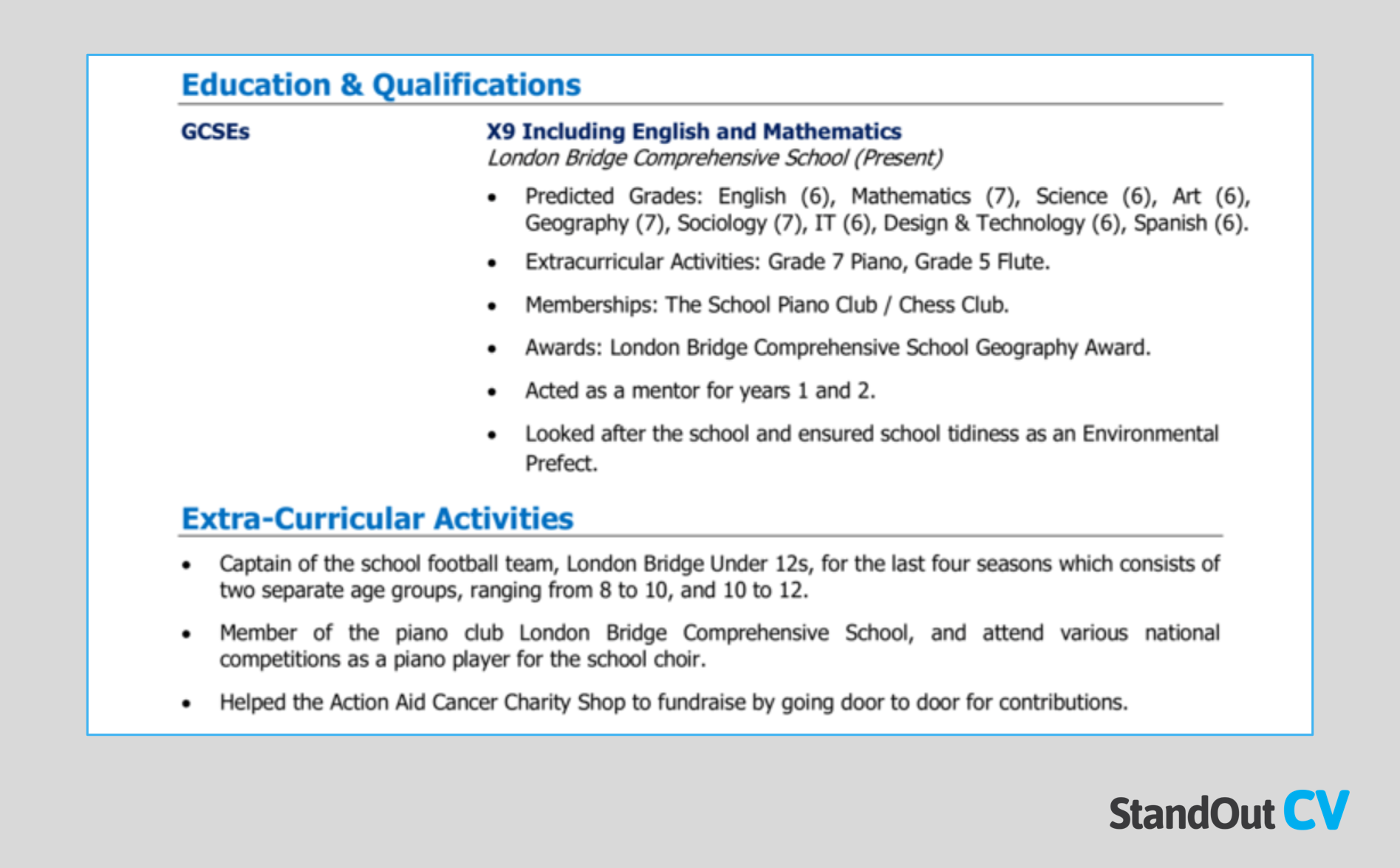
Baxton Hill High School – 2014 to 2019 10 GCSEs
- English (A) | Language & Literature
- Maths (A) | Achieved best coursework award
- Biology (B)
- Physics (B)
- Chemistry (B)
- Information Technology (A) | Specialised in Microsoft Office
- Geography (C)
Extracurricular activities and achievements:
- Grade 5 piano
- Grade 3 flute
- Captain of the school hockey team
- Voted ‘Most Spectacular Sportsperson of the Year’ in Year 10 and 11
Because this makes up the basis of your educational background, you can afford to outline all of your subjects and grades in more detail.
You could also include any awards or clubs in which you participated, it might look a little something like the above.
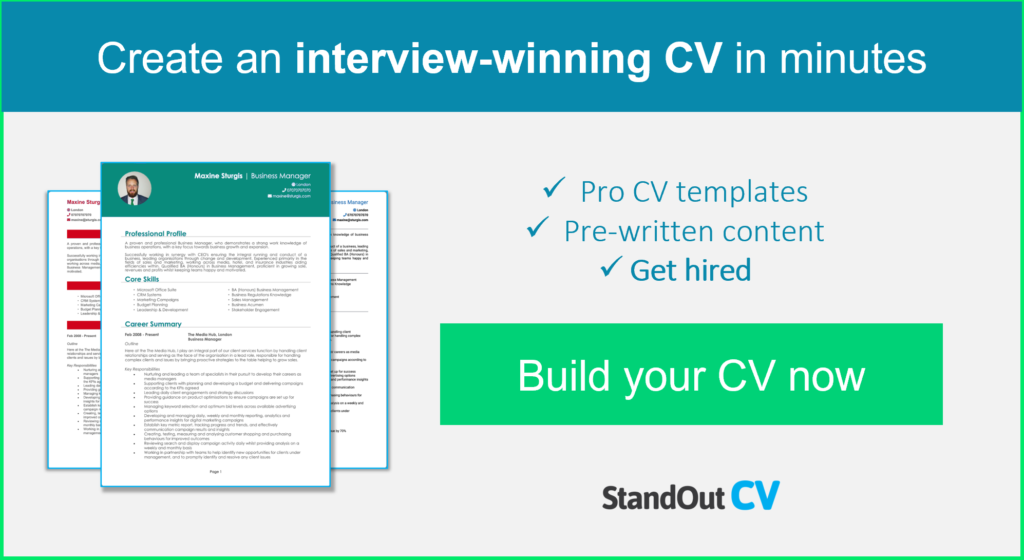
College leaver
As a college leaver, you will still need to include your GCSEs, particularly if they are relevant to the role you’re applying for, but your main focus should be on your more recent A-Levels.
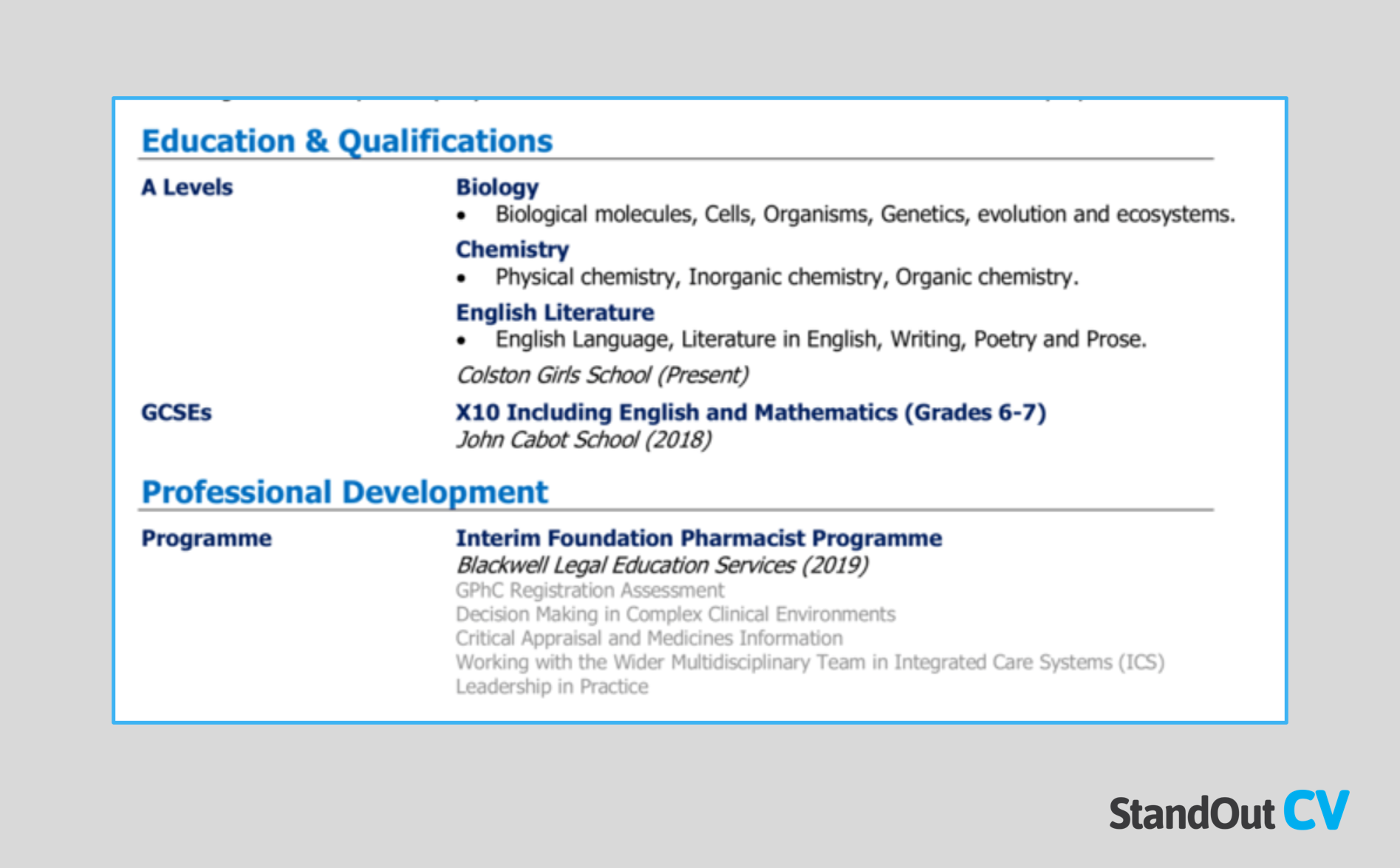
London Central College – 2019 to 2021 3 A-Levels
- Photography (A) | Including wildlife photography project and paper
- English Language (A) | Studying “Of Mice and Men”
- Graphic Design (B) | Completed a complete product design of a toy package
Achievements
- Practical experience in Adobe Photoshop, Illustrator and InDesign
- Proficient using DLSR camera, as well as experience developing film in the darkroom
- Achieved A grade and finished in top 10% of my class for print media and photography project
Baxton Hill High School – 2014 to 2019
10 GCSEs grade A to C including English, Maths, IT and Art
As you study fewer subjects at A-Level (typically three to four), you can give a bit more detail about each subject, your grades and anything else that could boost your application.
For example , you could outline particular projects that you were proud of or some of your key achievements. In this case, your education section might look a little something like the above.
Experienced professional
After college, or perhaps even during your time at college, you may have chosen to undertake a vocational qualification as a way of boosting your skills and gaining some real-world experience. This could be in the form of an NVQ , BTEC or a diploma.

City & Guilds NVQ (L1) in Hospitality Skills – 2020 – 2021
- Learning to maintain a safe, hygienic and secure working environment
- Working with the team to prepare, cook and safely store food
- Industry-standard training in kitchens and restaurants around London
London Central College – 2018 to 2020
A-Levels including English Language (A), Business Studies (A) and Food Science (B)
Baxton Hill High School – 2013 to 2018
10 GCSEs grade A to C including English, Maths and Food Technology
So although your experience in the workplace will likely take precedent on your CV, your education section is still important, and you need to give a little more detail about your vocational qualifications.
You can still include any A-Levels you have as well as GCSEs, but these should be kept to brief summaries like the above.
Recent Graduate
As a recent graduate , your degree is going to be one of your key selling points, particularly if you don’t have a great deal of work experience behind you.
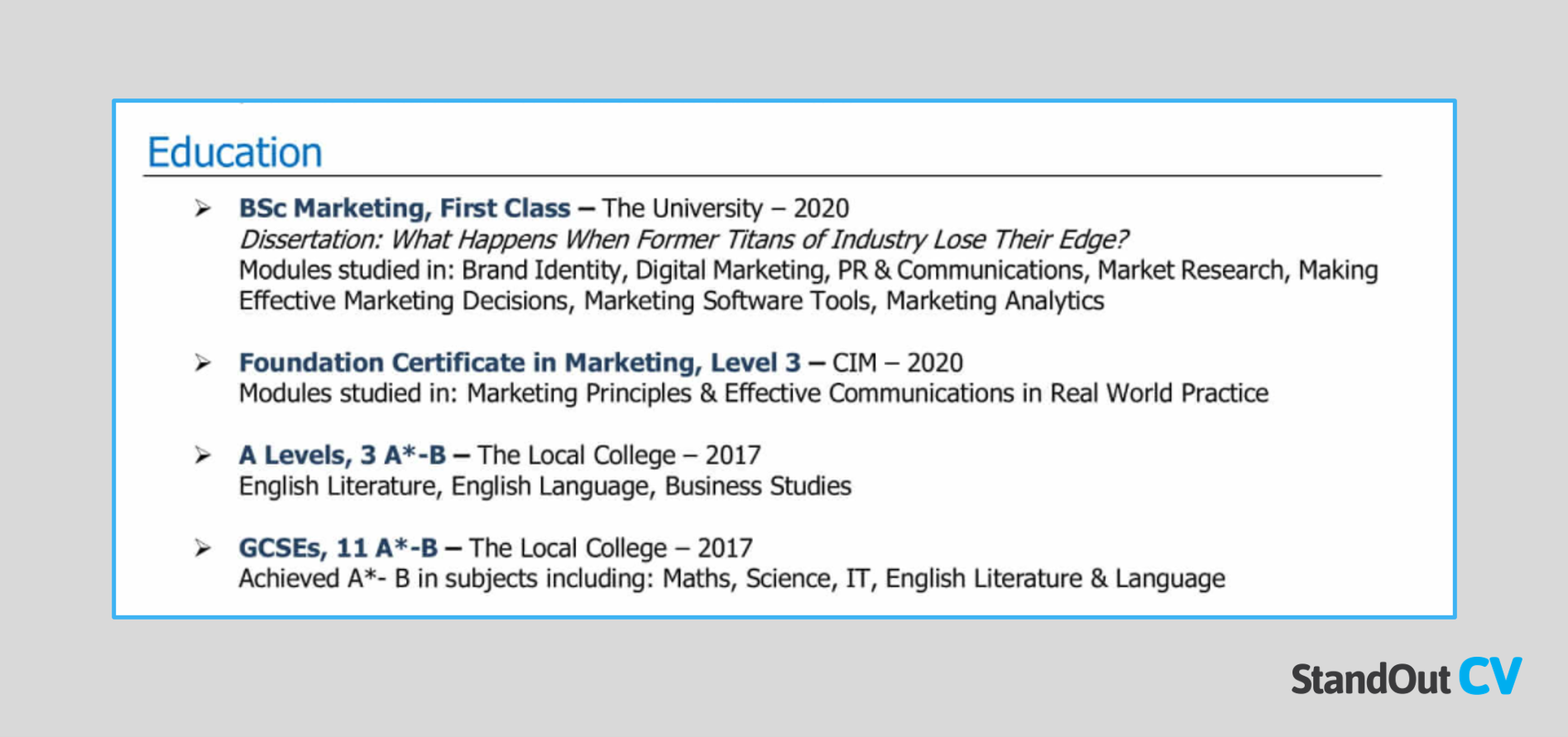
BSc (Hons) Computer Science – Queen Mary University – 2018 – 2021 Final grade: 1st Class
- Modules including: Big data processing, data mining, Artificial Intelligence (AI) and algorithms and data structures
- Achieved a 1st (96%) for my dissertation on ‘issues with privacy and security when dealing with big data’, coming top of my class
- Gained practical experience in software engineering, procedural programming and data mining
A-Levels including Information Technology (A), Business Studies (A) and Graphic Design (B)
10 GCSEs grade A to C including English, Maths and IT
You will still need to include your A-Levels and GCEs, but these sections don’t need to contain as much detail. Your focus should be on showcasing your degree, the key skills you gained and any achievements during your studies. You might also include any modules you studied that are relevant to the role.
The format should include the type of degree, as well as the full title, and you should include any honours along with your final grade.
Experienced Graduate
If you are a graduate with experience, whether that is because you left university a few years back or because you undertook a work placement as part of your course, this section can be less detailed.

BA (Hons) Digital Marketing – Queen Mary University – 2018 – 2021 Final grade: 2:1
- Modules including: Interactive media technologies, media streaming and the Cloud, programming for data analysis and personalising the digital experience
A-Levels including English Language (A), Media Studies(A) and History (B)
10 GCSEs grade A to C including English, Maths and Media Studies
You should still include your degree, A-Levels and GCSEs as shown above, but you can give fewer details, as the focus will lie with your real-world experience.
That said, this section should follow a similar format, including the type of degree and the full title, the university you attended and your final grade. In this case, your education section might look something like the above.
How to write your education on your CV
No matter what stage you’re at in your career, knowing how to structure , format and effectively showcase your education on your CV is critical. To help you get it right, we have pulled together some of our top tips for nailing your education section.
Adapt for your experience level
As we mentioned earlier, you should always include your educational experience in reverse chronological order, listing your most recent qualifications first. You also need to adapt this section depending on your level of experience.
You can see in the examples we’ve given above, if you’ve got work experience behind you, then you can afford to be more sparing on the details. However, if you don’t have a lot of relevant experience to speak of, you should go more in-depth about your key subjects, skills and achievements in your education section.
Only include relevant qualifications
As with every section on your CV, you need to make sure that you’re only providing information that is relevant to the role and employer. Otherwise, you could be wasting valuable space.
The more experience you have behind you, the less detail you need to give in terms of your education. Therefore, you can leave out any qualifications that aren’t relevant to the role. This is the reason you don’t need to list all 10 of your GCSEs unless this is the only educational background you have.
The same applies when you include your modules, achievements or extra-curricular activities. If they aren’t relevant to your career path, you are better off saving that space for something that is.
Use bullet points and break information up
Finally, it can be helpful to use bullet points throughout your education section, particularly when going into more detail about your experience. This is because bullet points can improve the format, make your CV more readable and help draw the recruiter’s attention to the details that matter the most.
Remember, you only have a few seconds to grab their attention and impress them, so you need to make it as easy as possible for the reader to find the key information quickly and effortlessly.
How to List Education on a Resume in 2022 (With Examples & Tips)
Not sure what degree to list? If you should include a GPA? It just so happens that there's a variety of ways to effectively list your eduction.

The education section of a resume may not always be the star of the document but knowing how to properly list your education can be essential for advancing into the next phase of the hiring process.
In this guide, we will cover all the ins and outs of crafting an education section for your resume.
We'll cover the following:
- What to Include in an Education Section?
Tips for Listing Degrees (College, High-School, GED)
Listing incomplete education.
- Where to Include Education on a Resume?
What Employers Look for in an Education Section
Beautiful resume templates to land your dream job.

What to Include in an Education Section
As we've covered, different formats of resumes may require different information to be included within an education section.
In general, there is some basic information that should be included within the education section of a resume:
- The name of the school — "e.g. Georgia Institute of Technology"
- The location of the school
- Your degree ( high-school diploma, GED, associate’s degree, bachelor’s degree, etc. )
- Graduation year ( if applicable )
- Major field or department of study (if applicable )
- Minor field or department of study (if applicable and relevant )
- GPA ( If you're a student or graduates who held lower GPAs, this bit of information may be good to omit unless specifically requested by the employer )
Here's what that looks like for and university grad:
Georgia Institute of Technology • Atlanta, GA B.S. in Computer Engineering, 2006 - 2010 GPA: 3.9/4.0
For high-school students, you can do something like the following:
Georgia Institute of Technology • Atlanta, GA High School Diploma, Graduated in 2010 GPA: 3.9/4.0
Remember, including a GPA is optional. Only add it if it's required by the job listing or it's relatively high. If your GPA is low (under 3.5), it's better to just leave it out.
Listing Education with Limited Work Experience
In resumes that have limited or no work experience , as may be the case with college students or recent graduates, the education section may be a good opportunity to show off educational achievements instead.
Additional information that can be included in longer education sections can include:
- Internships completed as part of a curriculum
- Academic awards or sponsorships
- Relevant coursework
- Academic assistantships with professors or other academic professionals
As covered, in documents such as CVs the education section could be fairly lengthy.
However, the education section for most resumes will be one of the shortest sections.
This is mostly because standard resumes will be used for entry-level or mid-level positions, while longer-form resumes like the CV will only come into play for more prestigious or hard to obtain positions.
It is much more important to show either a robust work history or detail relevant and transferable skills, using your education as support rather than the main point of interest.
Here are some quick tips for deciding what educational information to include in a resume:
1) When including professional hobbies and extra curricular activities, it is important to keep relevance in mind
Incorrect: Do not include information about sports clubs or other clubs that cannot be connected back to your qualifications for a job.
Correct: If you held leadership positions in clubs or other extra-curricular activities, this can be useful information to include to highlight non-paid leadership or management experience.
Keep your descriptions simple and concise
Incorrect: Including long-winded and wordy paragraphs explaining the relevance of a certain piece of information. If a piece of information is relevant, it should be easily explained in one, simple sentence.
Correct: Use bullet points to separate bits of information to keep your resume easy to read or skim.
The readability of a resume can be the defining factor of whether or not a job recruiter or potential employer moves the candidate into the next phase of the hiring process.
As such, using clear and concise wording and formatting is essential for not just the education section, but for all sections.
Here are a few tips for different formatting options depending on the level and type of education you have completed.
1) Adding High School and GED on Resume
- If your highest level of education is a high school diploma or a GED, this should still be included as there are many jobs that are open to high school graduates as well as college graduates.
- Generally, this type of education section should be kept short and sweet. Listing that you have received either a diploma or a GED should be sufficient.
- If you have recently graduated high school or received your GED, including additional high school-related achievements may be beneficial (such as leadership positions, honor roll awards, athletics, etc.)
2) Adding Associate’s and Bachelor’s Degrees on Resume
- When listing an associate’s or bachelor’s degree on a resume, always include the name and location of the institution, as well as the date or expected date of graduation.
- While the education section should still be kept short, inclusion of any collegiate level academic achievements, such as honor societies or dean’s lists, can be useful to include.
- Don’t go too crazy including coursework of extracurricular information – stick to including the most relevant information.
3) Adding Graduate School or Doctoral Programs on Resume
- Graduate and doctoral students may feel inclined to always include this information; however, it is important to be wary of including too much academic information in scenarios where it may render you overqualified for the position.
- Graduate and doctoral information is more likely to come into play for candidates seeking higher level positions at the management level.
- For candidates seeking jobs in academic or scientific fields, a CV-style resume and longer-form education section providing higher level of details regarding graduate or doctoral programs may be necessary.
4) Adding Certifications on Resume
- In some cases, a candidate may not have attended college but may have completed a trade school or other program that resulted in various certifications. These certifications should be included when relevant.
- Certifications such as CPR or First Aid can be useful to include in most resumes, although they should perhaps be saved for a separate certifications section .
5) Listing Incomplete Education on Resume
Incomplete education can be tricky to include in a way that sounds positive — as such, if you have incomplete education, be wary of your wording and avoid words such as “incomplete” or “unfinished.” Instead try to do the following:
- Include relevant coursework or credits earned during your duration of education before the point of departure from the institution.
- Omit any wordy or lengthy explanations of why the education is incomplete.
However, we've seen this be a common problem that many candidates have. Continue reading below to see how to effectively list education that is left incomplete.
In some cases, a job applicant may have a partially-complete or incomplete educational credential they want to list on their resume.
Incomplete education can result from a variety of circumstances, including:
- A person who is still in the process of earning their diploma, GED, or degree, but has not yet earned the credential or graduated.
- A person who started a degree and completed relevant coursework, but ultimately did not finish the degree program.
- A person who chose a different career path than what they studied for, but still has relevant coursework for the new career path.
When listing incomplete education on a resume, it is important to stay highly mindful of how you are wording your limited educational credentials — as words such as “ unfinished ” or “ incomplete ” are not ideal to include within a resume.
Here are some quick examples on how to properly list incomplete education in the education section of a resume:
For applicants who are in the process of completing a degree, it is important to note the expected timeframe of completion.
Incorrect: B.S. in Communications University of North Carolina, Chapel Hill, NC Not yet complete
Correct: B.S. in Communications University of North Carolina, Chapel Hill, NC Expected graduation May 2021
For applicants who began a degree, but ultimately did not complete the degree, it is key to be mindful of how you frame the education you did receive.
Incorrect: University of North Carolina Chapel Hill, NC
Why is this incorrect? Sure, this example indicates you, at some point, attended a university.
However, it provides no insight as to what relevant coursework or studies you may have completed.
Here's the correct way to describe your educational experience instead:
Correct: University of North Carolina Chapel Hill, NC Completed 20 credits towards a BS in Communications
Alternatively: This could be a good opportunity to include a bulleted list of relevant coursework.
For applicants who did not complete high school, it is important to note if you either earned a GED or are in the process of earning a GED.
Incorrect: Watauga County High School Boone, NC Incomplete
Correct: General Educational Development Diploma Earned May 2021 — OR — Expected to earn May 2021
Generally speaking, the majority of jobs will require applicants to have earned at minimum a GED certification in order to qualify.
In some cases, an applicant may lack a degree but may be certified by a trade school.
For instance, a beautician would want to include any beauty and health related certifications or licenses earned under the education section.
Take a look at this resume example of a college student below to see how to do this.
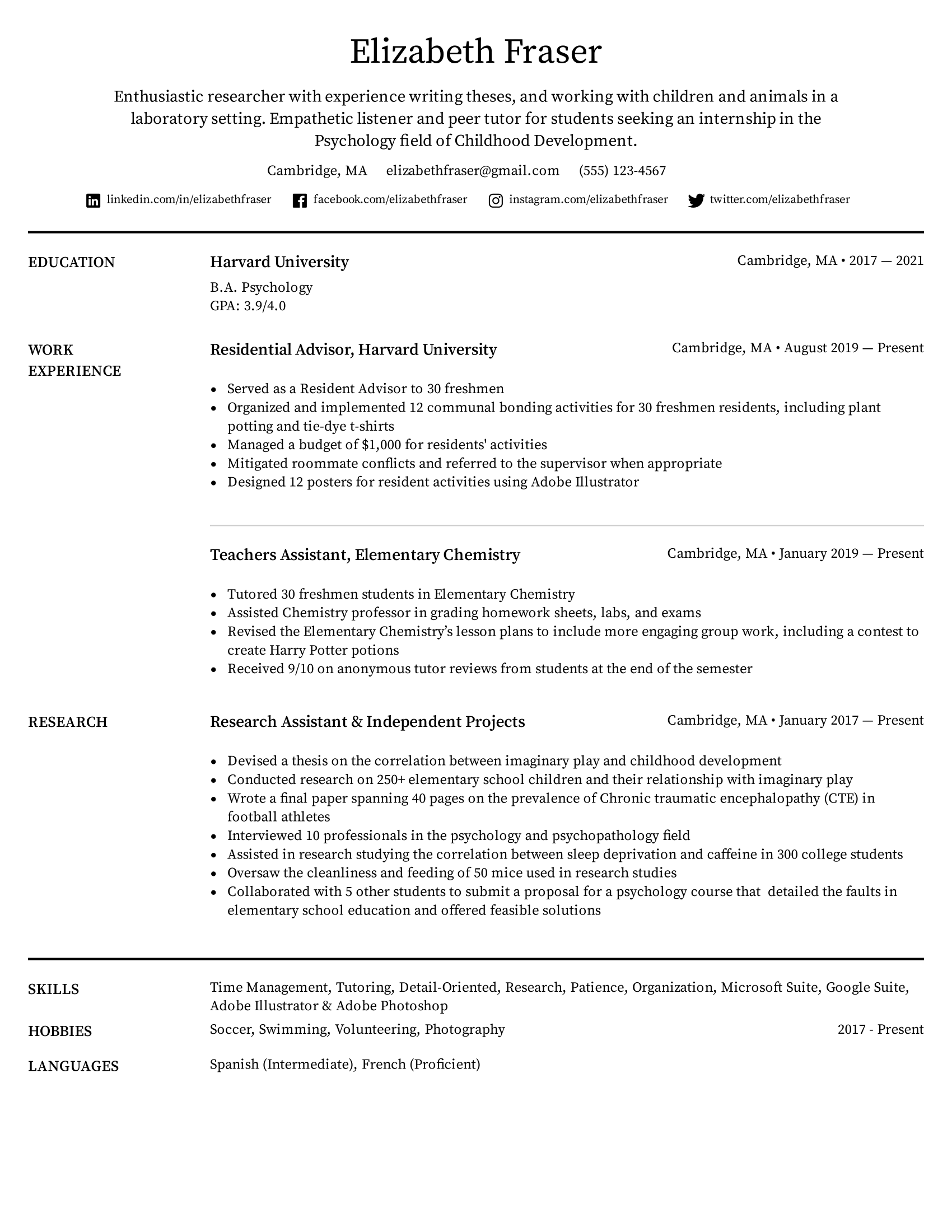
Where to Include Education on a Resume
When it comes to placing your educational credentials on a resume, there are many considerations to make.
Resumes can serve a variety of purposes and, as a general rule of thumb, should be tailored for specific jobs .
It is also important to take into consideration the level of education you have completed, as this will impact how it should be presented as well.
For instance, a job applicant seeking a position in academia would have a much heavier emphasis on education and academic-related achievements — than someone seeking a job in a corporate environment.
Ultimately, not all resumes are the same, so the placement of the education section will differ depending on the type of resume being used and the intention behind its structuring.
Choosing the right resume format
There are several different types of resume formats to choose from, but the main ones that are used are as follows:
1) Reverse-Chronological
Emphasis is placed on the most relevant work experience, listing jobs from most recent to oldest. Education can be placed before or after the work experience section. However higher degrees that qualify a candidate for the position may be beneficial to mention sooner rather than later.
2) Functional
Functional resumes place a much heavier emphasis on skillsets and areas of expertise. This format of resume is typically used by job applicants lacking the relevant work experience or educational credentials. In this format, the education section may lead if the applicant has educational credentials but limited work experience but should follow after the skills section if education is limited.
Hybrid resumes combine the reverse-chronological work experience ordering with the emphasizing of skills. This can help to supplement resumes of applicants who may have some relevant work experience but still need to beef up their resumes with a skills section . The placement of the education section will depend on how applicable or high level the credentials are and should generally be kept brief.
4) Curriculum Vitae (CV)
CVs are a type of long-form and multi-page resume used most commonly by applicants seeking positions in either academic or scientific fields. In a CV, the education section will be a prominent component and should appear early in the document. This type of education section should include all credentials, published works, projects, awards, or other academic achievements — no details should be spared.
The below example of a Physician Assistant's resume is listing education in the bottom-right corner as it's using a reverse-chronological resume format to shine on it's work history.
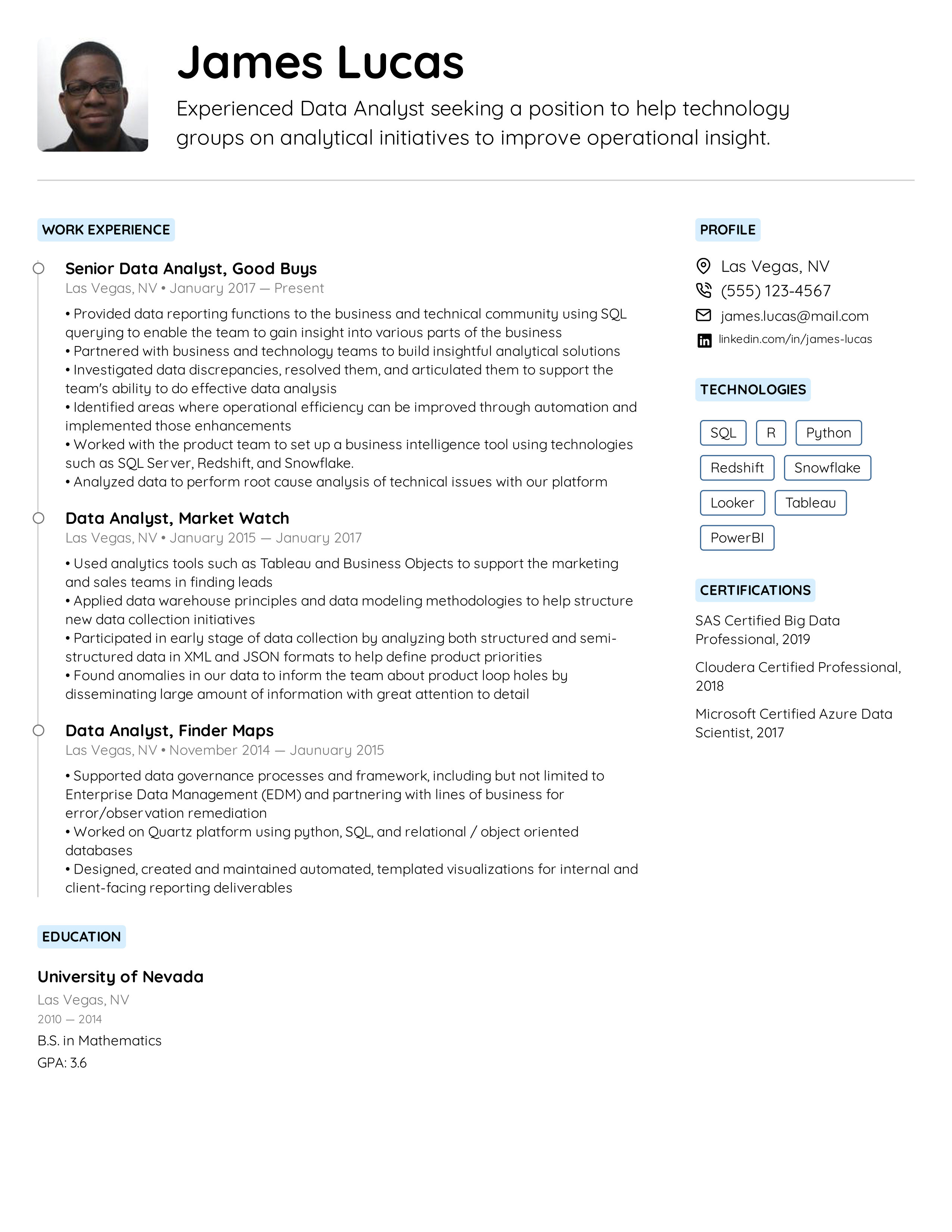
Employers can gather a variety of information about a job candidate from an education section, including:
- A job applicant’s work ethic, reflected through GPAs or other grade-related information
- Relevant skills or training an applicant has received through their schooling
- Name recognition of specific universities, such as ivy leagues, that may give a candidate a leg up on the competition
- Insight into a candidate’s interests or talents based on academic-related extracurricular activities included
Understanding what employers are looking for in an education section included on a resume is key to understand how much or how little information to include.
What an employer is looking for will vary depending on the nature of the job being offered.
For instance, an entry-level communications job at a corporation is likely to require a bachelor’s degree in communications or a related field.
Comparatively, a job in the welding industry may require the completion of a trade school program but not require a four-year degree.
It is of the utmost importance when you are applying to various jobs that you read the job descriptions provided carefully, as this is where you will find the necessary information regarding what educational credentials are required of eligible candidates.
This will also help you to tailor your education section according to what credentials or qualifications you have that meet the requirements of the job.
In general, what an employer is mostly looking for is simply that an education section exists on a resume.
The majority of employers will want candidates who have shown a commitment to their education, reflected through the inclusion of an education section.
For candidates lacking a completed education, it is still considered best practice to include some information regarding what level of education was reached before the point of incompletion, as well as the inclusion of any relevant coursework and knowledge gained from the time the candidate spent pursuing further education.
Here is a quick rundown of a few key factors to consider for applicants who may be unsure how much information to provide in an education section for a specific employer or position:
- The education section should prove that you have the credentials necessary to complete the job at hand.
- Oversharing of education can be detrimental in some situations, as overqualified candidates may not be considered by employers.
- Job descriptions will always be the best place to look for indicators regarding how much educational background information an employer is looking for.
- Never lie or over-exaggerate — while not all employers double-check applicants’ educational histories, many still do, and dishonesty can cost you the position in the long run.


Final Thoughts
Unless you are crafting a longer-form resume, such as a CV, the education section will generally be a fairly short summary of your academic credentials and achievements.
Education sections can be longer in some cases where job applicants may have hefty academic backgrounds but limited work experience.
Ultimately, the key to making a strong education section is to include only the most relevant information.
Always avoid deceptive wording, as employers can fairly easily run academic background checks if need be.
Check out our resume templates to get your creativity flowing and get started on your ideal resume today.
Browse more resume templates that fit your role

Get inspired with more resume examples
Read our how-to guides on making your resume perfect, how to write a resume header.
Your resume header is the very first thing an employer will see. Not only does it need to contain the correct information, but it needs to stand out as well! In this guide, we will teach you how to write the ideal header for your resume.
How to Write a Two-Page Resume (with Examples & Tips)
Don't know whether you should write a one-page or two-page resume? Find out when it is appropriate to write a two-page resume and learn how to write it correctly.
How to List Contact Information on Your Resume in 2022
Learn how to format contact information on your resume and what information to share with the hiring manager.
How to Include Hobbies on Your Resume in 2022 (With Examples)
Learn when and how to professionally list your hobbies on your resume.
More advice that will accelerate your career path
How long should a resume be in 2022 (with tips to fit on one page).
Keeping your resume on a single page keeps it focused and straight to the point. But sometimes it might not be easy to fit it all on one page. When should you use two pages versus trying to fit it all on a single page?
See How This College Student Landed 5 Internships
Learn essential strategies to land your first, second, or even fifth internship as a college student.
Should I Include a Photo on My Resume in 2022? (Tips & Examples)
To include or not to include (a profile photo or a selfie) — that is the question.
15+ Key Management Skills to List on Your Resume in 2022 (With Examples)
Pursuing a career in management gives you many opportunities for professional advancement. To land a management job, it is crucial to include the right skills on your resume. In this guide, we will discuss the best management skills and how to use them on your resume.
Professional resume templates to help land your next dream job.

Facebook • Twitter • Linkedin • Pinterest • Crunchbase

Protect your data
This site uses cookies and related technologies for site operation, and analytics as described in our Privacy Policy . You may choose to consent to our use of these technologies, reject non-essential technologies, or further manage your preferences.
- CV and Cover Letter
- How to list education on a CV...
How to list education on a CV (with examples)
7 min read · Updated on January 29, 2024

Learn how to write the education section on your CV
An education section is one of the basic requirements of a great CV, but it's crucial to ensure that it's in the right place and that you have the right level of detail. In this article, we'll share a few tips and discuss the main considerations to ensure your education has the right impact when listing it on your CV.
Why is it important to list education on your CV?
The education section enables hiring managers to assess whether you have the right academic qualifications for the job. This will carry greater or lesser weight in the recruitment process depending on how much work experience and relevant coursework you have. However, it's still considered to be vital information to include.
How to write an education section on a CV
Here are the basics of how to list education on your CV:
What to include in your CV education section
There are a few fundamentals the recruiter will expect to see in the education section of your CV. They include:
Name of the institution – school, college, or university
Qualification with grades
Dates of attendance or the year the qualification was awarded
If you're a recent university graduate, you should also include details of relevant modules to highlight your candidacy.
Where to list education on a CV
Where you position your qualifications depends on how recent your education is and how relevant your work experience is to your intended next steps.
Education leaver: If you're just leaving formal education, your academic record will carry more weight with a recruiter or hiring manager than your professional experience, so you should position an education section above your employment history.
Current professional: If you're settled into your career and have gained skills and knowledge through your work, then the employment history section will take precedence and education can be positioned below it.
Career changer: The exception to this rule is for those writing CVs to change careers . For example, suppose you've had a long career in retail but wish to pursue a career as an accountant. In that case, you can place education before employment history and include details of the accountancy qualifications and relevant coursework you're taking in preparation for the transition.
How to format the education section of your CV
A few general rules exist for adding your academic qualifications and achievements to your CV. Here are a few guidelines to follow:
Reverse-chronological order: Start with your most recent education and work backwards
Add extra detail: Include relevant modules, coursework, and awards if they will add weight to your job application
Formatting consistency: Mimic the formatting of your CV, including a bold section heading, bullet points, and sentence structure
When writing your education, use this template:
Institution name – Dates attended (from-to)
Qualification/subject – Grade
Or, for space-saving, you could try a more compact version:
Qualification, grade – Institution – Year
How to list your education if you're still studying
You can still list a qualification on your CV if you're working towards completion. You just need to clarify that it still needs to be finished. For example, say “In progress” or “Due to complete in 2025.”
You'll need to include the level of the qualification, such as BSc (Hons) or MBA, as well as the name of the course, like “International Business” or “Sports Therapy.” You should also include the name of the educational institution awarding the qualification ‒ usually the name of your university.
Modules, projects, dissertations, and theses can also be listed, focusing on the higher-level work and modules of particular interest or relevance. You can also mention if you're a member of any clubs or societies relevant to your chosen career path.
As your high school education or undergraduate degree is the main selling point on your CV at this time, you should also include any lower-level qualifications you have. Level, subject and year of completion are enough details here.
If you're still studying, your education section may look like this:

How to write your degree on your CV
It's always best to include any postgraduate or undergraduate degrees on your CV, no matter where you are in your career. If you're a seasoned professional, lower-level qualifications can be omitted if they don't add anything of value to your application.
Recent graduates will still need to include all of the details above and the completion date of the high school diploma or college degree. If you received a strong grade – a first or a 2:1 – you can also include that.
In this case, you may list further education like this:

How to write your A-Levels and GSCEs on your CV
Suppose you have no plans to go to university and are planning to start work after finishing your formal education at school or college. In that case, you must include more details about the qualifications you've achieved there. The level of the course, the subjects and the years of completion are the bare minimum.
Also include any strong grades, defined as grade C or above for A-levels and grade 4 or above for GCSEs (grade C for those slightly older!).
If you held any positions of responsibility during your studies and academic career, you could include those too – maybe you were a prefect, football team captain or student council member. Once you have some work history behind you, you can omit this level of detail.
Your education section could look like this for now:

Writing education on a CV: FAQs
What should i include in my education section if i have professional experience.
When you have some strong work experience or professional training under your belt, you need less detail in your education section; your career will carry more weight with a recruiter at this stage. However, you should still include a top-level summary of your highest level of education.
One line stating the level of qualification and subject is enough. For university-level qualifications, include the name of the institution as well. Do include the year of completion unless there's a risk of age discrimination. Suppose your qualifications were O-levels or CSEs rather than GCSEs. In that case, you might want to consider leaving them off completely ‒ even without stating the year, your age is implied, and ageism could affect your application.
At this stage of your career, your education section may look like this:

What should I do if I started a qualification but never completed it?
Incomplete qualifications or unfinished education should not be mentioned at all. Even though there may be perfectly valid reasons for not completing a course, when written in summary and compared against the CVs of other candidates, it looks weak.
If eliminating the qualification or incomplete education creates a large and unmistakable gap in your CV , you may need to include it to cover the gap. In this case, try to present the incomplete qualification positively.
For example:

What should I do if my grades are poor?
If you didn't quite achieve the grades you hoped for, the solution is easy: leave them out! A third-class degree is still a degree. For GCSEs or A-levels, list only the subjects that you passed.
How often should I update the education section of my CV?
Your education is integral to the CV, so it should be reviewed every time you update the document with a new job or ongoing course. Make sure that you still have the right amount of detail for your experience level and that irrelevant parts are removed. You should gradually move from a long and detailed section to a one-liner as you progress from high school or college student to seasoned professional.
Ultimate objective
In summary, your aim for the education section is to ensure that it complements your career goals by being relevant and sufficiently detailed. You won't go far wrong with this golden rule as your guide.
Are you properly showcasing your education and other academic achievements on your CV? Find out by getting a free CV review here .
This article was originally written by Jen David and has been updated by Laura Slingo.
Recommended reading:
How to write first class honours on a CV
Certifications on your CV: how to list them - with examples
How to make a CV for your first job
Related Articles:
What File Format Is Best for Your CV? Pros + Cons
Best fonts to use for a CV (with examples)
Should you put your address on a CV (with examples)
See how your CV stacks up.
Career Advice Newsletter
Our experts gather the best career & CV tips weekly. Delivered weekly, always free.
Thanks! Career advice is on its way.
Share this article:
Let's stay in touch.
Subscribe today to get job tips and career advice that will come in handy.
Your information is secure. Please read our privacy policy for more information.

IMAGES
VIDEO
COMMENTS
How to write an education section on a CV. Here are six steps you can follow to write the education portion of your CV: 1. Include the name and location of any schools attended. Providing the name and location of the school you attended provides the hiring manager or reader with an understanding of your level of education.
As a school leaver hoping to land a job, it’s likely that your GCSEs are going to be your highest level of qualification. When adding these to your CV, you should include the full name of your school and the dates you attended. Underneath this, you can begin to outline your GCSEs. Example 1. Example 2.
Let's start with the basics— what to include in your resume education section: Your most recent degree (or education in progress) The name of your school. Location of your school. Dates attended and graduation date (or expected graduation date) Your GPA (only if it's above 3.5) Your field of study and degree major.
In general, there is some basic information that should be included within the education section of a resume: The name of the school — "e.g. Georgia Institute of Technology". The location of the school. Your degree ( high-school diploma, GED, associate’s degree, bachelor’s degree, etc.)
1. Name of institution. You should always write down your school/university/college name in the education history CV. 2. Location. Simply include the city and country where the institution is located. 3. Type of degree obtained. State which degree/certification you received.
Here’s an example of a resume with the education section featured near the top: If you have more than a couple of years of relevant work experience, list your education below your work experience section. For most jobs, your education is less relevant to your ability to do the job than your hands-on work experience.
There are a few fundamentals the recruiter will expect to see in the education section of your CV. They include: Name of the institution – school, college, or university. Qualification with grades. Dates of attendance or the year the qualification was awarded. If you're a recent university graduate, you should also include details of relevant ...
The following are the components that should be included in the education section of a resume: The name of the school you attended. The state and city of the school you attended. The diploma or degree you received. The area of study you focused on while in school. The year you graduated or the year you expect to graduate if still in school.
Writing a CV education section can be confusing, but there are several ways for making the process trouble-free. 1. Place your CV education section strategically. If you’re writing a CV as a university student or applying for a job as a school leaver, you should put your education section first in your CV outline. Employers will be more ...